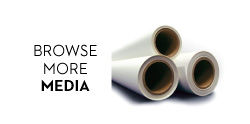Material de Termotransferencia HeatSoft™ PLUS ESM-HTM3
 El material de termotransferencia de calidad Premium HeatSoft™ PLUS ESM-HTM3 de Roland DG es un delgado y a la vez resistente material de poliuretano imprimible mediante inyección de tinta que genera imágenes bellamente y se estira y escarda con facilidad. Extremadamente versátil, HeatSoft™ PLUS ESM-HTM3 hace fácil y rápida la transferencia de gráficos a una variedad de materiales que incluyen algodón, poliéster, mezcla de algodón y poliéster, Spandex/Lycra® y cuero. El material de transferencia HeatSoft™ PLUS ESM-HTM3 ayuda a producir vestimentas y accesorios con suavidad al tacto, colores vibrantes y detalles excepcionales. Capaz de soportar hasta cincuenta ciclos de lavado, también ofrece una durabilidad insuperable. HeatSoft™ PLUS es fácilmente transferido levantando el gráfico desde su revestimiento posterior con la máscara de termotransferencia HeatSoft™ PGM-PTM2 de Roland DG, y aplicándolo a la prenda o accesorio. La máscara asegura la estabilidad dimensional de este material delgado y estirable durante el proceso de termotransferencia. El material de termotransferencia HeatSoft™ Plus ESM-HTM3 es compatible con las impresoras de la serie Versastudio®, VersaCAMM® SP-i y VersaCAMM® VS-i.
El material de termotransferencia de calidad Premium HeatSoft™ PLUS ESM-HTM3 de Roland DG es un delgado y a la vez resistente material de poliuretano imprimible mediante inyección de tinta que genera imágenes bellamente y se estira y escarda con facilidad. Extremadamente versátil, HeatSoft™ PLUS ESM-HTM3 hace fácil y rápida la transferencia de gráficos a una variedad de materiales que incluyen algodón, poliéster, mezcla de algodón y poliéster, Spandex/Lycra® y cuero. El material de transferencia HeatSoft™ PLUS ESM-HTM3 ayuda a producir vestimentas y accesorios con suavidad al tacto, colores vibrantes y detalles excepcionales. Capaz de soportar hasta cincuenta ciclos de lavado, también ofrece una durabilidad insuperable. HeatSoft™ PLUS es fácilmente transferido levantando el gráfico desde su revestimiento posterior con la máscara de termotransferencia HeatSoft™ PGM-PTM2 de Roland DG, y aplicándolo a la prenda o accesorio. La máscara asegura la estabilidad dimensional de este material delgado y estirable durante el proceso de termotransferencia. El material de termotransferencia HeatSoft™ Plus ESM-HTM3 es compatible con las impresoras de la serie Versastudio®, VersaCAMM® SP-i y VersaCAMM® VS-i.
Especificaciones
| Total Caliper: | 8 mil (película y revestimiento) |
| Basis Weight: | N/A |
| Whiteness: | N/A |
| Brightness: | N/A |
| Opacity: | 90% |
| Gloss Level: | 71 @1.2: 20° |
| Inkset: | Eco-solvente (Max y Max 2) |
| Adhesive: | Activado térmicamente |
| Backing: | Poliéster transparente |
APLICACIONES
- Textiles
- Apparel Decoration
- Leather Goods
Tamaños Disponibles
137 cm
76 cm (real: 75 cm)
51 cm (real: 50 cm)
Almacenamiento y Uso
El Material de Termotransferencia de Poliuretano HeatSoft™ Plus ESM-HTM3 debe ser manipulado con cuidado para evitar la contaminación que pueda estropear la superficie imprimible del producto. Esta película de poliuretano deberá ser procesada y almacenada en un entorno de entre 18°C y 24°C (65°F y 75°F) y una humedad relativa de entre 30% y 50% (sin condensación) que se encuentre limpio, relativamente libre de polvo y alejado de la luz directa del sol. Se recomienda almacenar este producto en su envase original, en un área fresca y seca, hasta que esté listo para su uso. Si las condiciones de almacenamiento están fuera del rango recomendado de operación, permita que el material se aclimate en el entorno de producción por lo menos entre 24 a 48 horas antes de su uso.

